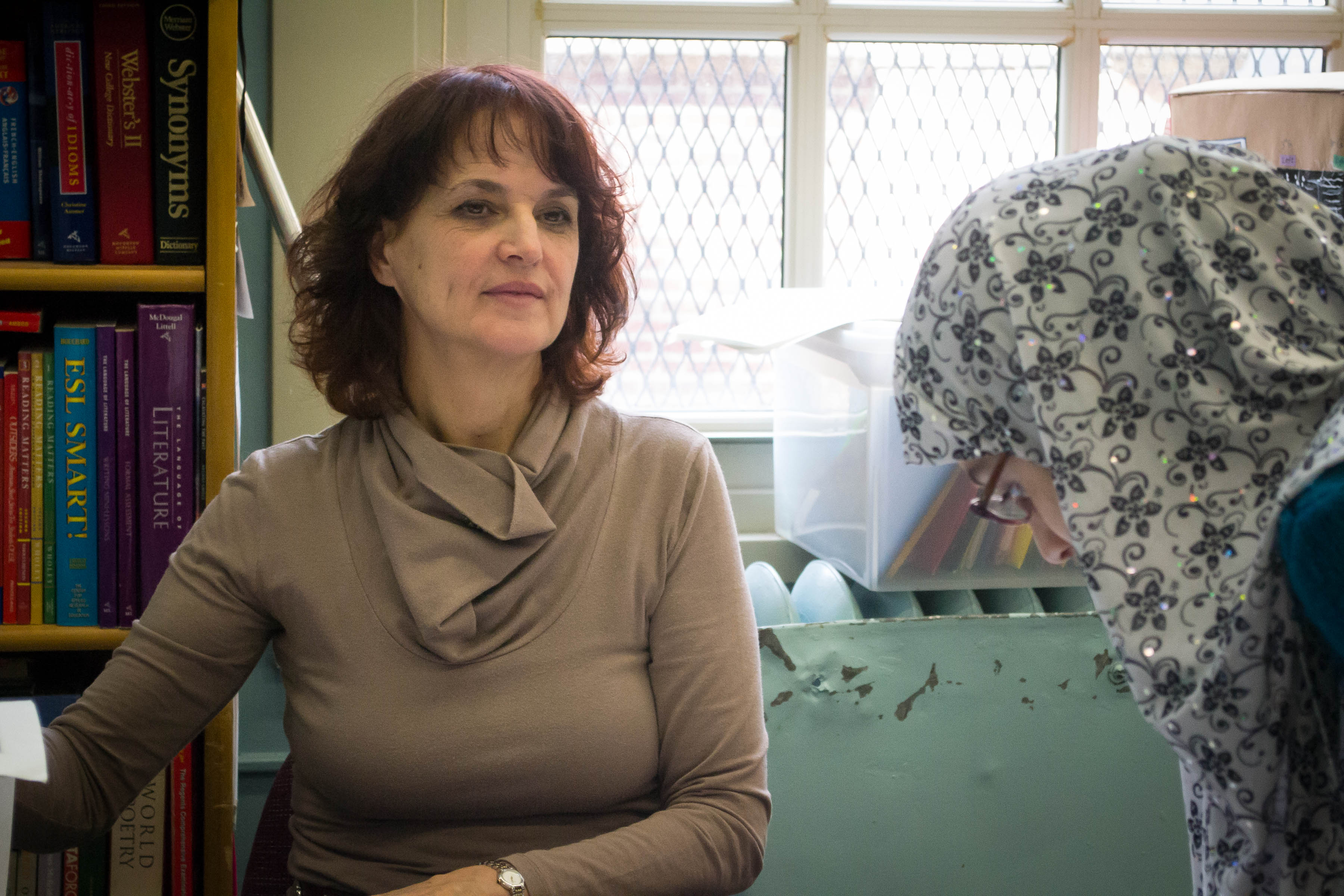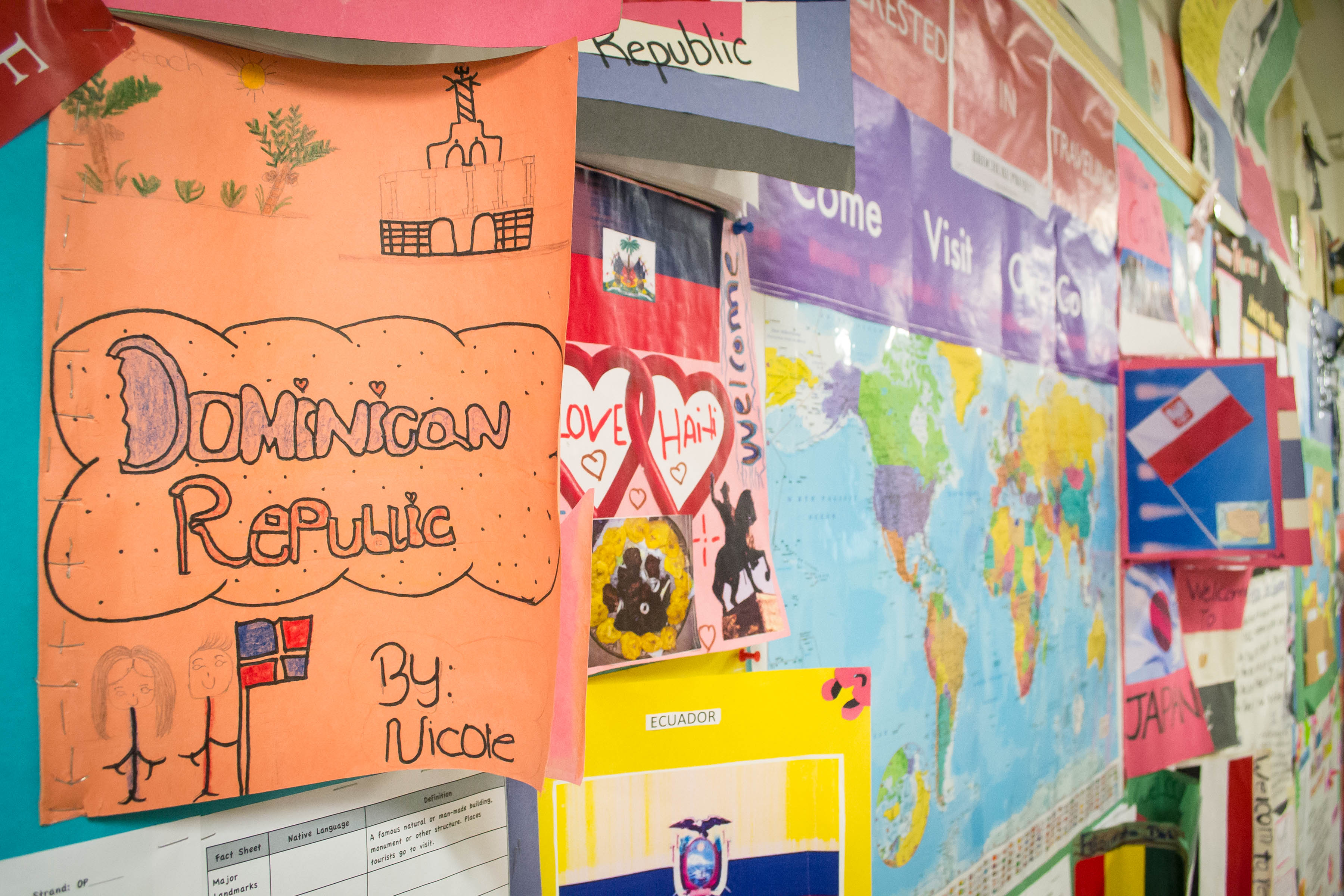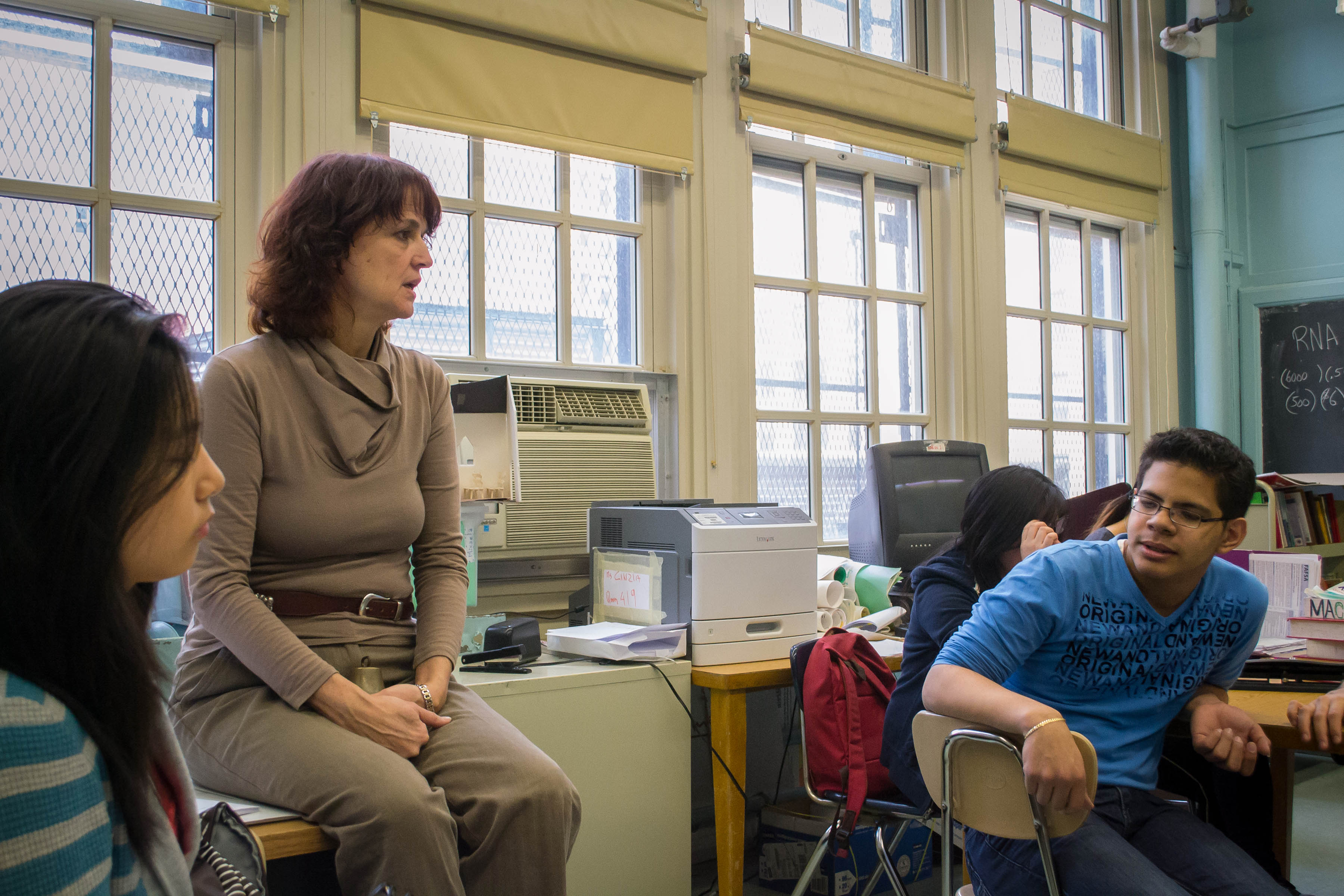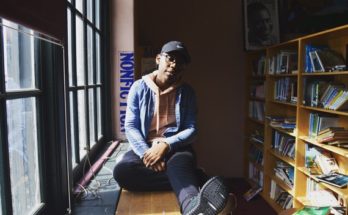
The aim for the day was written in large, cursive letters on the blackboard: “What is poetry and how does it convey truth?”
Cinzia Bontempo, the 12th grade English teacher at Manhattan International High School, rang a bell to quiet her students, most of whom were still feeling talkative just after lunch. Bontempo assumed her usual position sitting on the edge of her desk..
She wore jeans and a long-sleeved white shirt whose sleeves were pushed up to her elbows, as if she’d been washing dishes. When she stands, her presence is felt in the classroom—Bontempo, wearing boots, is over 6 feet tall. Even so, students call her by her first name, Miss Cinzia (pronounced chin-SEE-ah).
“What is poetry?” Bontempo asked her students, her short, auburn hair falling casually around her face. Three students raised their hands.
Bontempo called on Jing Wen Liao, whose thick Chinese accent made it difficult for her to be understood. Her classmates listened patiently while she repeated herself. A few students offered suggestions about what she was trying to say. Finally, the class figured it out. “Poetry is something that keeps my GPA low,” Liao said, on the fourth try. Her classmates laughed.
“What about music?” Bontempo asked. “Poetry is found in music all the time. Does anyone know any songs in English?”
One of the students belted out “Imagine All the People,” in a thick Dominican accent. Some of his classmates joined in, creating—for just a moment—one of the most international Beatles cover bands ever formed.
More than 50 countries are represented at Manhattan International High School, located on East 67th St. between First and Second avenues, is a public school that serves over 300 students, all of whom—when they applied to the school—had lived in the United States for less than four years. Students speak over 40 languages. And Bontempo knows what it’s like for her students to be far from home.

“The things that I miss the most are the songs from my past,” Bontempo said, pausing ruefully for a moment. A few nodded their heads in agreement.
When Bontempo, 60, moved to New York in 1998, she was leaving behind a successful 20-year career as a furrier in the Italian fashion industry. Her career was unorthodox, at least in this part of the world. “I was the best I knew,” she said.
Bontempo wasn’t raised in the world of fashion. Born in Trieste, a seaport in northeast Italy, she lived the first 10 years of her life in a refugee camp built by Americans after World War II. The Yugoslavian People’s Army ran the camp, after receiving authority over parts of Trieste from the Allied forces, until the final borderline with Yugoslavia was settled in 1975. “Growing up in a border city was painful,” she said. It was in the refugee camp that Bontempo says she developed her interest in racism and discrimination, which she often discusses in her English classes.
Trieste was the kind of place where residents would check the flag every morning to determine which country they belonged to. Bontempo’s grandmother, who lived through both World War I and World War II, was born Austrian, became Italian, then Yugoslavian, and died Italian. “She never went more than twenty miles in her life,” Bontempo said.
Back in New York City, Bontempo’s students can appreciate the power of borders. “I told them the story of my grandmother to talk about how political geography affects people. In previous years, I had students from Serbia, Albania, Bosnia, so they were very interested in that,” she said.
She began working with fur because she loved to sew and eventually started her own company. But the animal rights community “didn’t allow” her business to succeed, she said. So she decided on a drastic change: move to New York, learn English, and work in the travel industry.
It wasn’t until she went to LaGuardia Community College and took her first English classes that she realized that her heart was in languages. “I loved it. I loved to help my fellow students. When I took my first travel business class, I thought, ‘This is not me.’ I’m not a businessperson. I like the creative side of things,” she said. So she worked for her bachelor’s in English and education, and then went to Hunter College, where she got a master’s degree in teaching English as a second language.
Much like her students, Bontempo had a daunting primary goal in the United States: learn English. When counselors at LaGuardia accidentally put her in an accounting class during her first semester, before she completed her remedial English classes, Bontempo felt dejected. “I would go home crying because I couldn’t understand the man. I dropped out, and felt like such a failure.” The next semester, she took the same class and got an A. It’s a story she loves to tell her students, simply to demonstrate the power of language.
Bontempo sometimes taps into her no-nonsense business pragmatism as a teacher. Lindsey Lin, a 17-year-old student who moved from China in the seventh grade, smiled broadly when asked about Bontempo’s teaching style. “She’s never put any of her students out,” said Lin, referring to Bontempo’s response if there is ever a behavior problem in her class. “She’s calm.”
Lin remembers when she had Cinzia for fifth-period English. The class would struggle with lethargy just after lunch. Bontempo’s solution? Open the windows.
In many ways, Bontempo’s classroom is no different from those attended by native English speaker. Stacks of “To Kill a Mockingbird” line the bookshelves; inspirational posters are tacked to the walls (“Life’s most persistent and urgent question is: ‘What are you doing for others?’”).
Because teachers share classrooms, linear equations are scrawled on the chalkboard, next to rules of grammar. The school focuses on providing students a traditional high school experience, while celebrating their unique cultural heritages. Students sell chocolate hearts at lunchtime for Valentine’s Day and learn about prom from “High School Musical.” Last week, the students beat the teachers in a well-attended volleyball game, 21 to 16. On Dominican Independence Day, the Dominican students hosted a bachata and merengue dance contest in the gymnasium.

Bontempo’s old profession is a far cry from her current focus: editing comparative literature assignments. During her second period class one morning, Bontempo hovered over a stack of papers on her desk, her brow furrowed while she furiously corrected essays. Sometimes, when she was editing, Bontempo held her head up with her left hand, seemingly entranced in a world of grammar, and Maya Angelou, and bibliographies.
Bontempo compares the adrenaline required as a furrier in the months preceding Christmas to the rush necessary to successfully correct 65 essays in less than a week. “As a furrier, you work like a dog for four months,” she said. “You have an enormous amount of work to compress. So I was already trained to make this effort in my life. It is a skill that I have inside of me: that sense of urgency. I spend months teaching literature, and that takes time. But then I have to read all of this stuff, and then I have a deadline too.”
While snow fell outside of Bontempo’s classroom last February, 13 students clustered in groups of three or four around wooden tables. Each was working on a laptop. The walls are painted robin’s egg blue, and are covered with student work and vocabulary words. The aim for the day: revisions.
“Once they get the green paper, they are approved,” Bontempo said. She held up a stack of papers, each with a grid and student names. She was editing their performance-based assessments—a fancy way to say essay, in this school’s English department—some for the fifth or sixth time. The majority of the names were already highlighted in green. “We’re almost done,” she said, her voice waning. She has 65 students, all of whom have been working on their comparative literature essays since the beginning of December.
Her students come from far-away places like Senegal, Botswana, Chile, Brazil, and Spain. And they appreciate having a teacher who understands their struggle. “Because she’s good at English and because English is her second language, it tells us that we can do it too,” Bing, a 17-year-old from China, said.
Bontempo, now in her eighth year teaching at Manhattan International, believes her past can help her students through the embarrassment of learning a language. “Sometimes in class, I say, ‘Very good,’ in a very Italian accent, and they laugh, but it’s just a little reminder to be comfortable,” she said.
The data aren’t clear, however, on how language learners can benefit from teachers who are not native English speakers. Education Next, a conservative journal focusing on K-12 grade education in America, explains in a 2004 study: “Experimental evidence suggests that teachers, in interacting with students, are more favorably disposed toward those who share their racial or ethnic background.” And Thomas Dee, a professor at Swarthmore College, completed a study in 2001 that found that students—both black and white—who were randomly assigned to an “own-race teacher” significantly increased their math and reading achievement by roughly three to four percentile points.
So what does this mean for English language learners?
Thirty-five percent of graduating seniors at Manhattan International are accepted into four-year colleges. The New York City Public School average of high-school seniors entering college is 68.9 percent, which includes students attending any type of college, from one community college class to a four-year university.
Last year’s report card issued an overall A to Manhattan International (and an A in student progress), and found that the school similarly prepares its students for college compared to other students in the city. The catch? The school’s four-year graduation rate is 56 percent compared with the district average of 73 percent. This isn’t because students are dropping out. It’s because it often takes students six years to successfully complete the graduation requirements—including an English Regents exam, which makes sense since the vast majority arrive as freshman knowing very little English.
The school’s six-year graduation rate is 83 percent.
Graduates of Manhattan International have attended a range of colleges from CUNY and SUNY schools to Wesleyan, Fordham, Columbia, Colby and Middlebury. The overwhelming majority of students attend community colleges. “They do go to college, and they want to,” Bontempo says of her students.
Fatou, a 17-year-old with braided pigtails, is still focusing on learning English, not a language she often heard in her native Senegal. But having Bontempo as a teacher makes sense to her. “She understands us, and can connect with us better. She’s been there,” Fatou said.
Bontempo lives in Kew Gardens, Queens, where she enjoys an older, small town feel. As for her old profession, she only misses the creative aspect of working with fur. For now, her cat—Hippo—provides her the physical aspect of her old job that she no longer has access to. “Touching and petting him gives me the physical aspect of it that I miss,” she said. “He’s my piece of fur.”
During lunchtime on a recent Thursday at Manhattan International, Bontempo used a fork to eat an organic beef burger and vegetables she brought from home. Cuiying, a meek, Chinese student with thick glasses, entered the classroom.
“Did you have lunch, sweetie?” Bontempo asked Cuiying, who was busy digging for a paper in her backpack. She wanted to review another draft of her comparative literature essay with Bontempo.
“No,” Cuiying said timidly, tucking her long black hair behind her ear. She wore a bright pink shirt that belied her shyness.
Bontempo smiled. “So why don’t you go have lunch and come back. I’ll be here,” Bontempo said. “I’m not going anywhere.”



